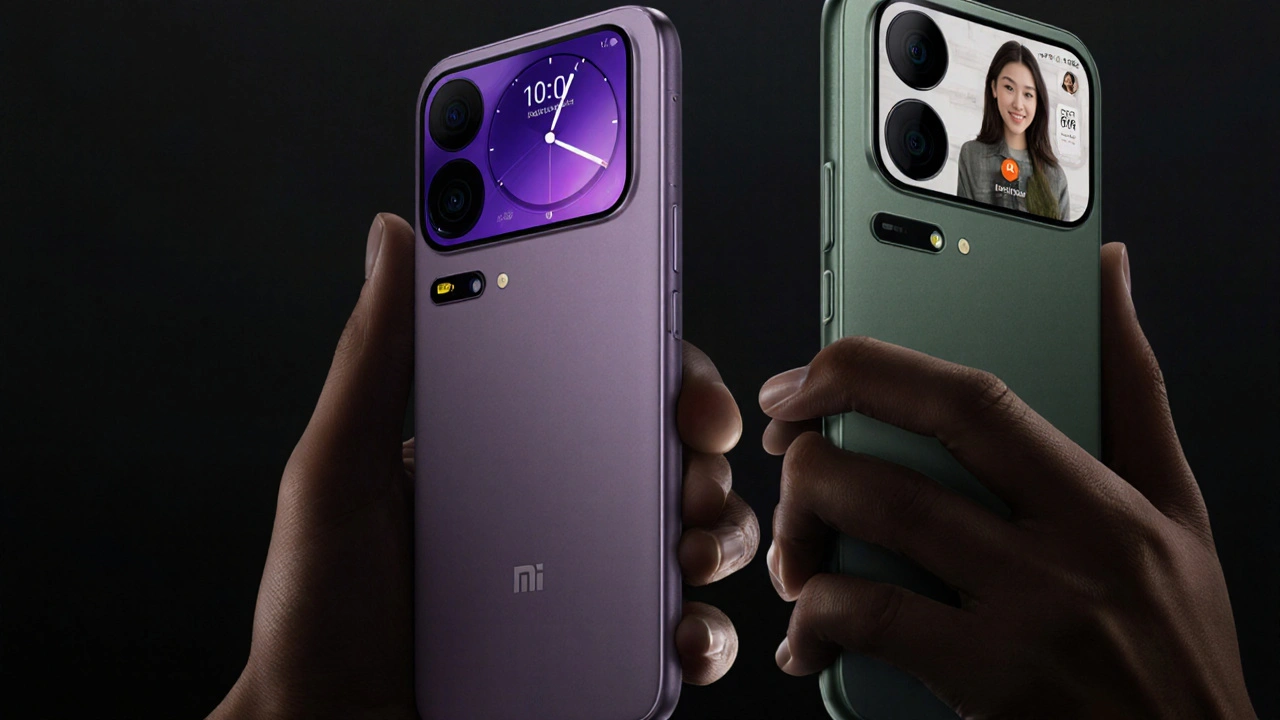On September 25, 2025, Xiaomi rolled out the Xiaomi 17 series, a trio of smartphones that mark the company's first foray into devices powered by Qualcomm's brand‑new Snapdragon 8 Elite Gen 5. The move isn’t just about new hardware; it’s a calculated play to line up directly against Apple’s upcoming iPhone 17 series, even skipping the "16" moniker to keep the numbers in sync.
Specs and Innovations
All three models – the base 17, the 17 Pro, and the top‑end 17 Pro Max – share the same silicon heart: a 3nm‑fabricated Snapdragon 8 Elite Gen 5. Qualcomm claims the chip delivers CPU speeds that sit shoulder‑to‑shoulder with Apple’s A19 Pro, while the GPU shows a 34.6% uplift over the previous Snapdragon generation. The die area stays at roughly 126.20 mm², but the addition of 6 MiB on‑chip memory and dedicated SME (Scalable Matrix Extension) blocks points to a serious push for on‑device AI. Expect faster image‑recognition, real‑time translation, and smarter contextual computing.
What really grabs attention are the Pro models’ rear‑facing secondary display, dubbed "Xiaomi Share Back Screen." Measuring 2.7 inches, this strip wraps around the camera module and works like a mini cover screen on modern flip phones. Users can view notifications, control music, or even frame selfies using the rear camera as a viewfinder – a handy trick for vloggers and selfie lovers alike.
The 17 Pro Max pushes the envelope on power. A monstrous 7,300 mAh battery paired with an M10 OLED panel promises marathon usage without the constant charger chase. The display boasts HDR10+ support, a 1440p resolution, and a 120 Hz refresh rate, delivering buttery‑smooth scrolling and vivid colors for gaming or media consumption.
- Processor: Snapdragon 8 Elite Gen 5 (3nm, 6 MiB on‑chip cache)
- GPU: 34.6% performance boost over Snapdragon 8 Gen 4
- RAM/Storage: 12 GB/256 GB base, up to 16 GB/1 TB in Pro Max
- Rear secondary display: 2.7‑inch, touch‑enabled
- Battery: 5,200 mAh (17/Pro), 7,300 mAh (Pro Max)
- Display: 6.7‑inch (17), 6.9‑inch (Pro), 6.8‑inch M10 OLED (Pro Max)

Strategic Implications
CEO Lei Jun used the launch stage to articulate a five‑year transformation roadmap. After a reflective period that began in 2020, Xiaomi has surged past RMB 200 billion in annual revenue and entered the Fortune Global 500. Yet Lei admits the company still feels a twinge of nervousness when eyeing Apple, Samsung and Huawei.
To close the gap, Xiaomi is committing another RMB 200 billion (about $28 billion) to core technology development. A sizable slice of that budget is earmarked for semiconductor research, acknowledging that building an in‑house SoC is a decade‑long, $7 billion‑plus gamble. For now, the partnership with Qualcomm and the use of TSMC’s 3nm process give Xiaomi a credible performance narrative without the massive upfront risk.
The timing of the announcement – just weeks before Apple’s expected iPhone 17 debut – isn’t accidental. By unveiling a flagship that matches Apple’s chipset performance and adds unique hardware tricks like the rear screen, Xiaomi is positioning itself as a viable premium alternative, especially for markets where price sensitivity meets a craving for high‑end features.
Analysts are already tweaking their forecasts. The 17 Pro Max’s 7,300 mAh battery could appeal to power users in emerging economies where charging infrastructure lags. Meanwhile, the AI‑centric SME blocks hint at future software upgrades that could keep the devices fresh long after launch.
Overall, the Xiaomi 17 series isn’t just a new phone line; it’s a statement of intent. By marrying cutting‑edge silicon, daring design choices, and a massive investment in technology R&D, Xiaomi signals that it’s ready to sit at the same table as the industry’s biggest names.

Nilanjan Banerjee
September 27, 2025 AT 00:16Behold, the Xiaomi 17 series arrives upon the stage of consumer electronics like a phoenix soaring over the smoldering ruins of mediocrity. Its Snapdragon 8 Elite Gen 5 heart beats with the vigor of a thousand freshly‑minted cores, daring to rival the hallowed architecture of Apple’s forthcoming A19. The audacity of a 3nm silicon monolith in a company previously content with incremental upgrades is nothing short of theatrical brilliance. One cannot ignore the secondary rear display, a sleek 2.7‑inch tapestry that whispers promises of futurist ergonomics and selfie‑centric wizardry. Moreover, the gargantuan 7,300 mAh battery in the Pro Max version sings a hymn to endurance, mocking the perpetual anxiety of low‑charge warnings. Strategically timed, this unveiling challenges the very mythos of Apple’s hegemony, inviting consumers to reconsider loyalties. Whilst the price point remains undisclosed, the implied value proposition screams a manifesto of affordable excellence. In essence, Xiaomi dares to rewrite the rules of premium flagships and invites the world to witness its bold proclamation.
sri surahno
September 27, 2025 AT 01:06The unveiling, dear readers, is not merely a product launch but a clandestine maneuver orchestrated by the hidden cabal that straddles Qualcomm and Apple alike. One must ask: how did Xiaomi secure such a cutting‑edge 3nm chipset without the shadow of a covert quid‑pro‑quo? The timing-mere weeks before Apple’s iPhone 17 reveal-betrays an intentional ripple in the grand tapestry of tech dominance. Their proclaimed "independence" is, in truth, a veneer masking the deep‑rooted collusion among the silicon elite. It is morally reprehensible that consumers are lulled into believing they have a genuine alternative when, in fact, the same oligarchic interests profit from every purchase. The addition of the rear secondary display is a gimmick designed to distract from the underlying compromise of user data to undisclosed entities. Do not be fooled by glossy marketing; this is a subterfuge aimed at eroding the sovereignty of digital autonomy. In this era, vigilance is the only shield against the insidious spread of corporate totalitarianism.
Varun Kumar
September 27, 2025 AT 01:56Xiaomi’s partnership with Qualcomm is a front‑row seat to the global tech cabal’s agenda.
Madhu Murthi
September 27, 2025 AT 04:26Guys, this is a massive power‑move by our own tech giants 🇮🇳💪 The rear screen? Pure genius for content creators and power users alike. It’s like they read our minds and gave us what we needed before we even asked for it! 🔥📱
Amrinder Kahlon
September 27, 2025 AT 05:16Wow, a rear screen-because nothing screams "innovation" like adding another place to stare at ads while you’re already glued to the front. Sure, it looks cool, but I bet it just drains more battery and adds another crack‑prone surface. Guess we’ll all be buying screen protectors for both sides now. 🙄
Abhay patil
September 27, 2025 AT 07:13Look, the Xiaomi 17 lineup brings serious hardware upgrades and a fresh design language that could shake up the premium market. It’s great to see a brand pushing the envelope with a 3nm processor and a massive battery, especially for users in regions where charging is a challenge. While the price isn’t disclosed yet, the specs suggest a competitive offering against the upcoming iPhone. I think we should give the community a chance to test these devices before forming any conclusions. Let’s keep the discussion constructive and focus on real performance data when it becomes available.
Amber Brewer
September 27, 2025 AT 08:36From a technical standpoint, the Snapdragon 8 Elite Gen 5 chipset represents a significant leap forward in mobile processing power. Built on a 3nm process, it offers a higher transistor density, which translates to better performance per watt compared to the previous generation. The 6 MiB on‑chip cache and the inclusion of SME (Scalable Matrix Extension) blocks suggest a strong focus on AI and machine‑learning workloads, enabling faster on‑device inference for tasks like real‑time translation and image recognition. In practice, this should result in smoother multitasking, quicker app launches, and lower latency for gaming. The GPU boost of approximately 34.6 % over Snapdragon 8 Gen 4 means higher frame rates and more detailed graphics in demanding titles. The varied battery capacities-5,200 mAh for the base models and a massive 7,300 mAh for the Pro Max-provide flexibility; the larger battery will likely sustain heavy usage for upwards of two days, especially when paired with Xiaomi’s adaptive power management. The M10 OLED panels with HDR10+ support and a 120 Hz refresh rate deliver crisp visuals and vibrant color reproduction, which is critical for media consumption and gaming. The rear secondary display, while a novelty, can also serve practical functions such as quick notifications, music controls, and even use as a viewfinder for selfies, potentially reducing the need to flip the device. Connectivity-wise, the phones support Wi‑Fi 6E, Bluetooth 5.3, and 5G sub‑6 GHz, ensuring they are future‑proof for network upgrades. Software updates are expected to be more frequent given Xiaomi’s commitment to AI‑centric features, so the devices should stay fresh for several years. Finally, the pricing strategy remains to be seen, but if Xiaomi can undercut Apple and Samsung while offering comparable specs, it could drive substantial market share gains, especially in price‑sensitive emerging markets.
Kim Coulter
September 27, 2025 AT 10:00In the grand tapestry of technological evolution, the Xiaomi 17 series stands as a testament to the restless spirit of progress that refuses to be shackled by legacy. It is not merely a device; it is an embodiment of a philosophy that challenges the monolithic narratives perpetuated by established behemoths. By harnessing cutting‑edge silicon and daring design, it asserts that innovation belongs to the many, not the few. This bold statement reverberates beyond specifications, echoing a call for democratized excellence in a world where power often masquerades as exclusivity. Let us embrace this paradigm shift, for true greatness is forged in the crucible of competition and shared ambition.